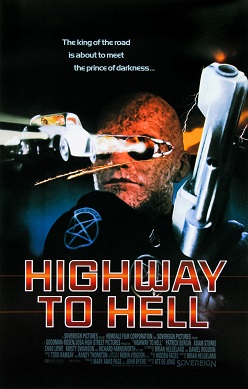




The Ate de Jong directed, comedy-horror film "Highway to Hell" is released.
Charlie Sykes and Rachel Clark are a young all-American couple that decide to run away and elope in fabulous, Las Vegas, Nevada.
A funny thing happens on the road to Vegas, they completely ignore the warning of a local gas station attendant, Sam, when they're told to avoid backroads. As expected, they take an abandoned backroad where Rachel is kidnapped by a zombie Hell Cop who takes her to Hell. Charlie goes back to the gas station to ask Sam what the hell a Hell Cop is and how to save her. Sam then gives him a shotgun with special ammo, and a car that has a very custom option. On the highway, Charlie meets other dead people that live in Hell and even a zombie motorcycle gang. On the road, he meets a mechanic named Beezle, with his young apprentice. Beezle gives him tips on how to save his girlfriend. After Charlie rescues Rachel, Beezle reveals himself to be Satan (Beezle-bub, get it?! [sarcasm]) and proposes a deal to let them, and his apprentice, go free if they can defeat a Hell cop in a race to the portal that connects Earth and the backroads of Hell.
Confused? Trust me, it's not hard to follow.
It has Oscar-worthy performances by Lita Ford as The Hitchhiker girl, Gilbert Gottfried as Hitler, Ben Stiller as Pluto's Cook/Attila the Hun and Ben's mom, Anne Meara as Medea, waitress in Pluto's and dad, Jerry Stiller as The Desk Cop.



















